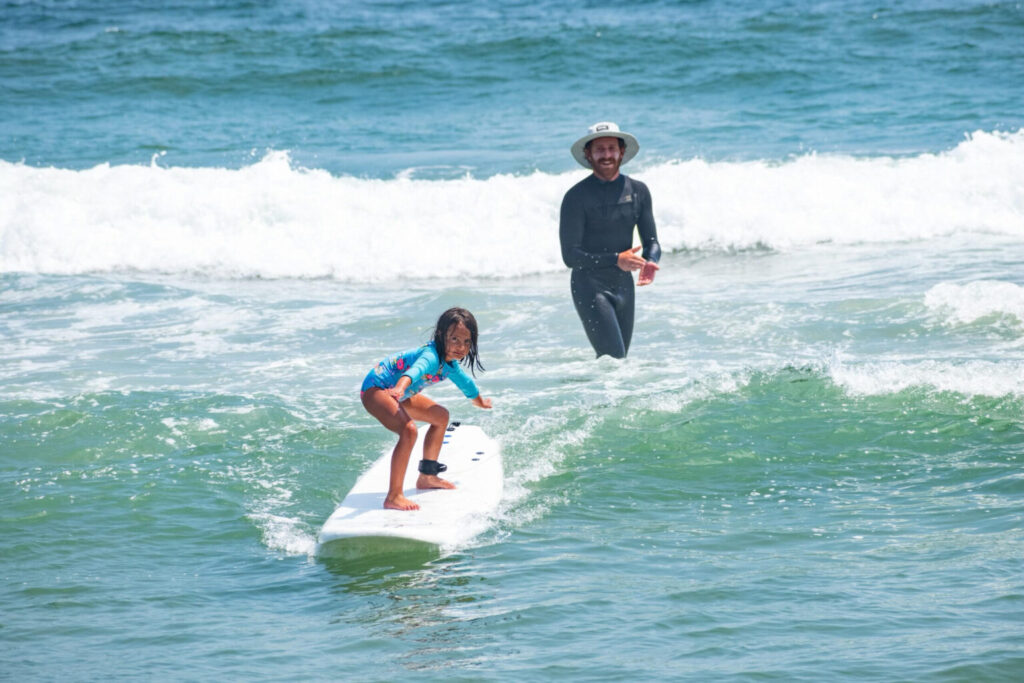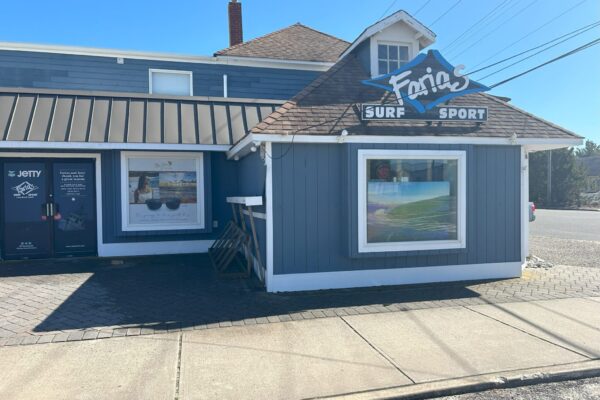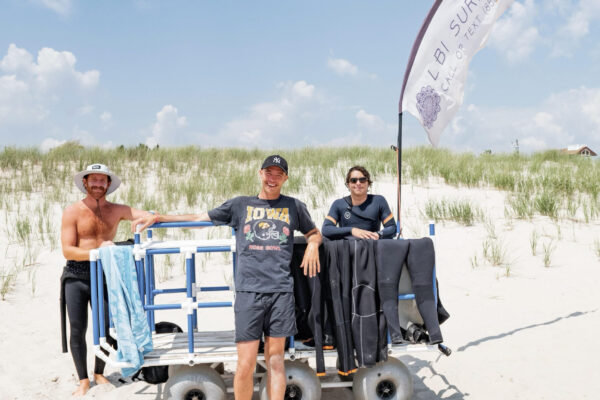Joey Aji is the owner and founder of LBI Surf Guru. Since 2013, they have collectively taught over 2000 new surfers on the island.
Surfers often feel as if they should not encourage others to learn how to surf. Built into surfing is a natural scarcity of resources; where in other activities there are no shortage of balls to throw or pavement to ride – there are a finite amount of waves breaking on Long Beach Island today.
Let’s dive into the math.
Below is a common problem statement:
Your average surfer (a) is usually able to pick from a certain amount of waves (x). We now add a new surfer (b) out in the water. New surfer (b) decides to bring 5 ambitious friends who also happen to be new to the game. Throw in a family of 6 draped in t-shirts, who seemingly are hard of hearing, because no matter how hard and long the lifeguard blows the whistle, they just keep on drifting. Last but not least, we have an oblivious boogie boarder who appears to forgot what board they’re affixed to and is now in the surf zone.
Now, how many waves does our average surfer (a) have to catch?
a = x – (b+5b) – boogie boarders – t-shirt family
Now I am not here to be your math tutor – but I’ll tell you right now – it’s not looking good for our average surfer (a). BUT our average surfer (a) need not worry because it turns out math is FAKE – and if beginner surfer (b) and his little buddies follow a few simple rules of the ocean then everyone, even those boogie boarders, will catch some waves!
Surfing Rules & Tips 👇
Part 1: Rules of the Ocean
There are a few rules that are important for new surfers to know before they step foot in the water.
- Be Cool – Just be generally nice, say hi to people, ask questions. You will be welcomed with open arms.
- Wait Your Turn – Out in a busy ocean there will usually be some semblance of what is called a “lineup”. When someone has been waiting for a wave longer than you have and a wave comes, you should probably just let them catch it and grab your spot in line.
- The Inside Has Priority – Most (all?) waves break from either left to right or right to left. The person that is closest to the peak (which is the highest point of the wave and where it will first start to break) has priority, meaning you should not try to catch this wave if said inside surfer is paddling on it.
There are a bunch of other stuff like try not to ditch your board (especially if someone is paddling out behind you), wear sunscreen etc. etc. but unfortunately I have gotten bored of this section and rules are meant to be broken. Surfers are a benevolent bunch and as long as you follow rule #1 – all will be forgiven.
Part 2: Equipment
So you are all ready to start your surfing journey, you head over to Farias and eye up the $1200 10ft Longboard sitting on the rack – but then you remember you will also need a wetsuit to stay warm at $250. Also, you might need boots for those cold days, so tack on another $130.
You almost forgot wax, Sticky bumps, Sex Wax (you smile and nod), Base Coat? Yep. Warm and Cold Water wax? Take both.
What about goggles? You are going to need goggles so water doesn’t get into your eyes.
You juggle your goods up to the counter, bars of wax spilling through your hands with a heavy dose of capitalist fueled dopamine running through your veins.
BUT WAIT!!!!
There is a better way – take a few SURF LESSONS before buying any equipment. Give a call to Joey (that is me) from Long Beach Island’s best and highest rated (Google it!) surf school – LBI Surf Guru.
We will be able to get you out in the water without breaking the bank (or any bones) and we will point you towards all the right equipment after your lesson (spoiler: it is not that $1200 longboard).
Part 3: Best Beaches to Surf on LBI
*****REDACTED******
Parts of this section have been removed to protect the identity of Long Beach Island surf spots.
All you need to know is that almost every beach on LBI is suitable for surfing (outside of a few beaches all the way on the north end of Barnegat Light that never really break). Just make sure you are surfing in the designated surfing zone if you are surfing during lifeguard hours.
Lifeguard hours are different depending on what township and what time of summer we are in but in most cases they are starting at 10am going until 5 or 6pm (before and after lifeguard hours is a free-for-all).
Flags on the beach will represent the start and stop of surf and swim zones – the colors of these flags will also change depending on what town you are in so CHECK WITH YOUR LIFEGUARD if you are unsure.
I will say that 31st Street in Ship Bottom usually has a good sandbar suitable for beginners which conveniently enough is where LBI Surf Guru (LBI’s most fun and friendly Surf School) teaches lessons. Give us a call (or text)! Or if you don’t want to get your car all sandy then hit up Long Beach Island Surf Lessons (also me) which will come to your beach – anywhere on the island.
Part 4: When To Surf
As a beginner on LBI you are most likely going to be surfing during the summer. The water heats up throughout the summer months so September will be significantly warmer than June.
Conditions during the summer are usually pretty mild and good for beginners – just be aware that September is the start of hurricane season, which brings some of the biggest swells of the year.
A few things to check when picking a time to get out in the water.
- Tides- As a general rule of thumb – you want to surf any time in the 6 hour window around low tide (so 3 hours before and after low tide). The closer you get to high tide the greater chance you have of the waves not breaking. Waves break in shallow water (this is a good sign to look out for if you want to find a sandbar).
- Weather – Everyone wants to surf on a sunny day. But don’t be fooled, weather ≠ swell size so even the most mild sunny days can have very large swells. That being said – look out for days with light wind. In many cases the lighter the wind the better. The only exception to this is when the wind is blowing off shore (West to East) – a 10-15 mph off-shore wind can be great for conditions as it pushes waves up making them bigger and giving them some shape.
- Swell – Swell size is not equal to the weather on the beach BUT it is directly correlated to the weather out off the coast. And just like weather forecasts, swell forecasts are just educated guesses and are often wrong, but it’s still beneficial to check to get a general idea of what you may be walking into.
Two platforms I use to check conditions and tides are Surfline and Swellinfo. Also, you will be able to get some of this info from the chalkboard on the back of your lifeguards chair. If you are ever in doubt, always ask the nearest lifeguards.
Part 5: How To Surf
You made it – you are only one more section away from being able to absolutely shred.
SIKE – if only it were that easy.
I always say that the best way to learn how to surf is to go swimming. Just getting out in the ocean, body surfing and boogie boarding is really the only way to learn the fundamentals; where to sit in the water, when to paddle, and what waves to take.
Learning to surf is often a slow process – you need to build a foundation of physical fitness and knowledge of the water. The only way to fast track this is to get a lesson, preferably with (final plug) LBI Surf Guru.
But if you do decide to get out there on your own – you can watch a few Youtube videos, grab the biggest foam board you can (larger than 8ft), wait for a calm day with small waves, get out there near low tide, lay straight on your board with your toes all the way to the back, paddle hard, jump to your feet when you feel like you have the wave.
When out in the water make sure to follow rules 1-3. Or don’t – what do I care? I’m just excited to have you out there because, remember, math is fake and the only thing that is real is the time spent out in the water with your friends.
Frequently Asked Questions
What beaches can you surf on LBI?
Nearly every beach on LBI is suitable for surfing (outside of a few beaches all the way on the north end of Barnegat Light).
If you are surfing in-season(with lifeguards), make sure you are surfing in the designated surfing zone.
If you are surfing off-season, there are no restrictions.
Can I rent surf boards on LBI?
Yes. In fact, multiple shops such as Farias Surf Shop offer daily and weekly rentals.







